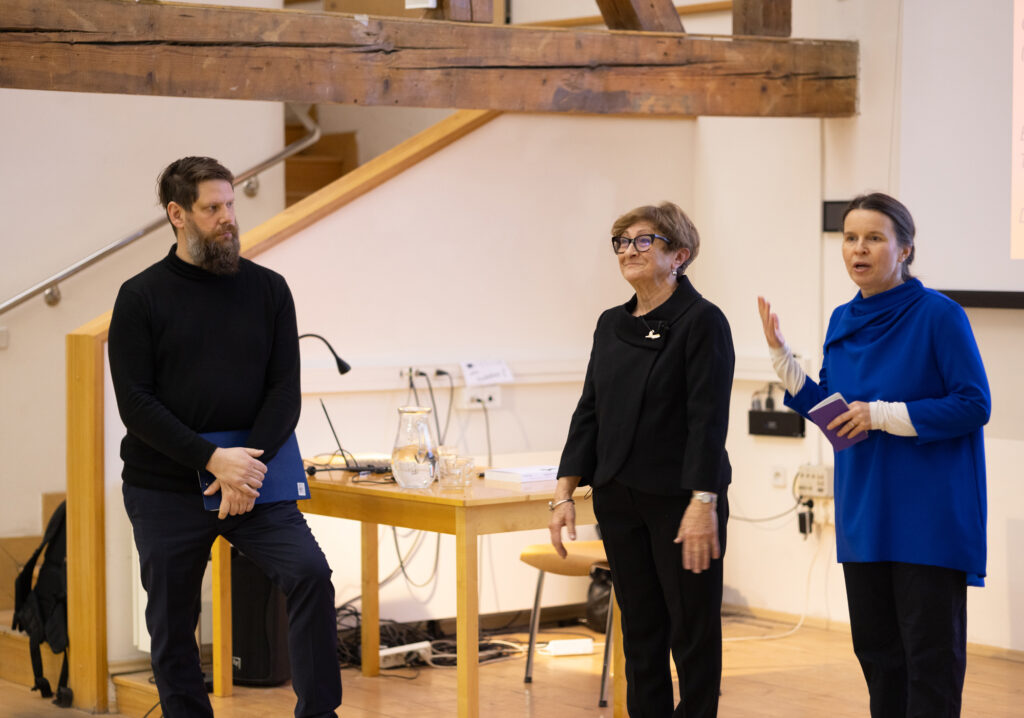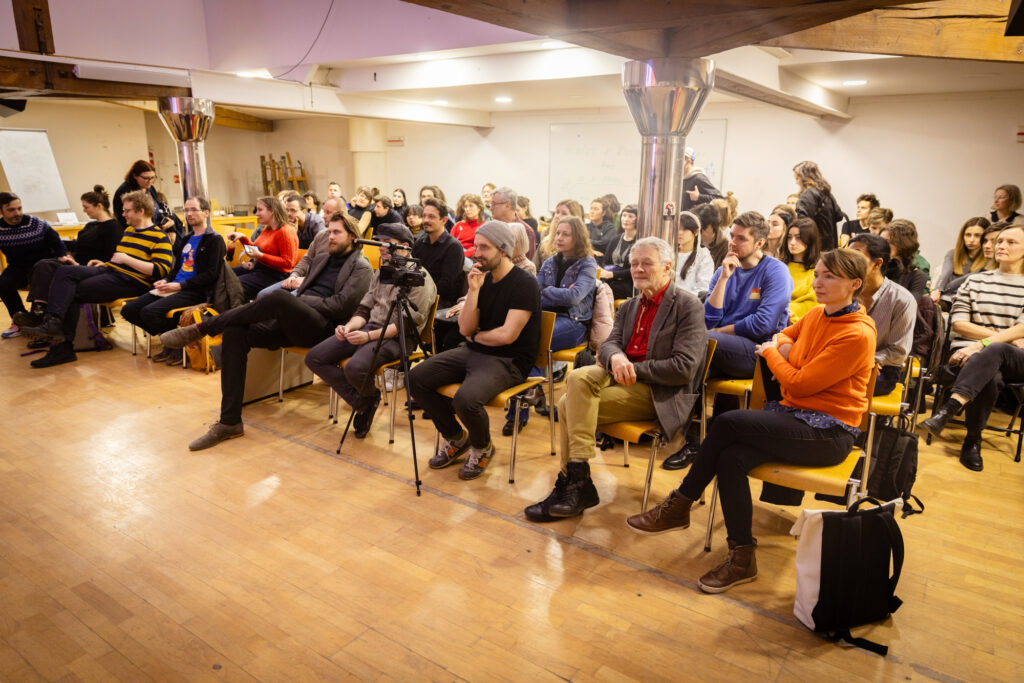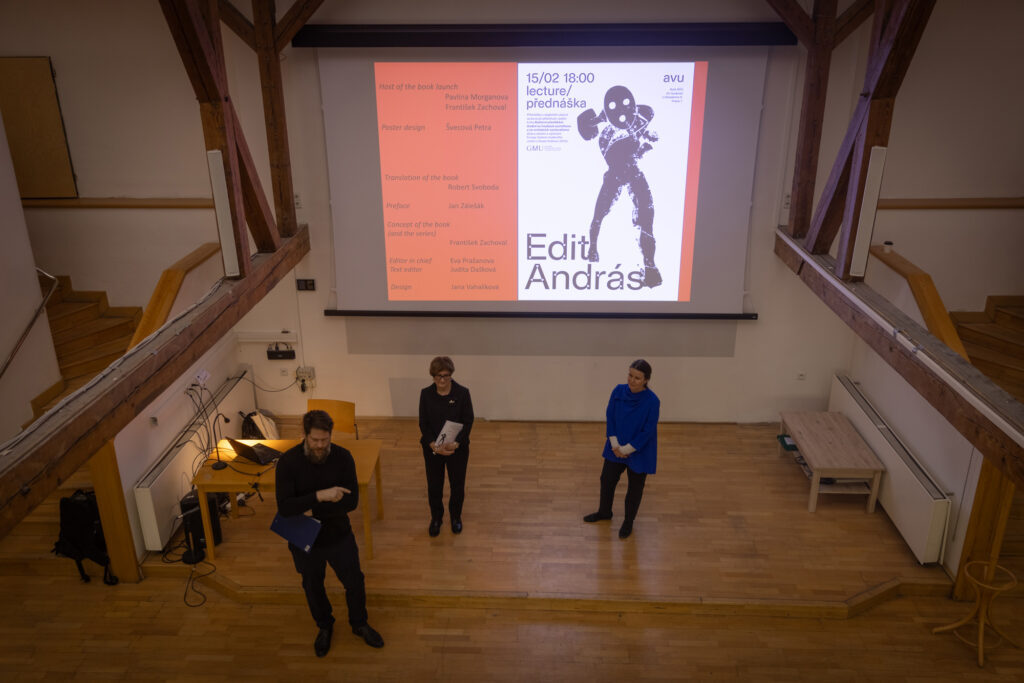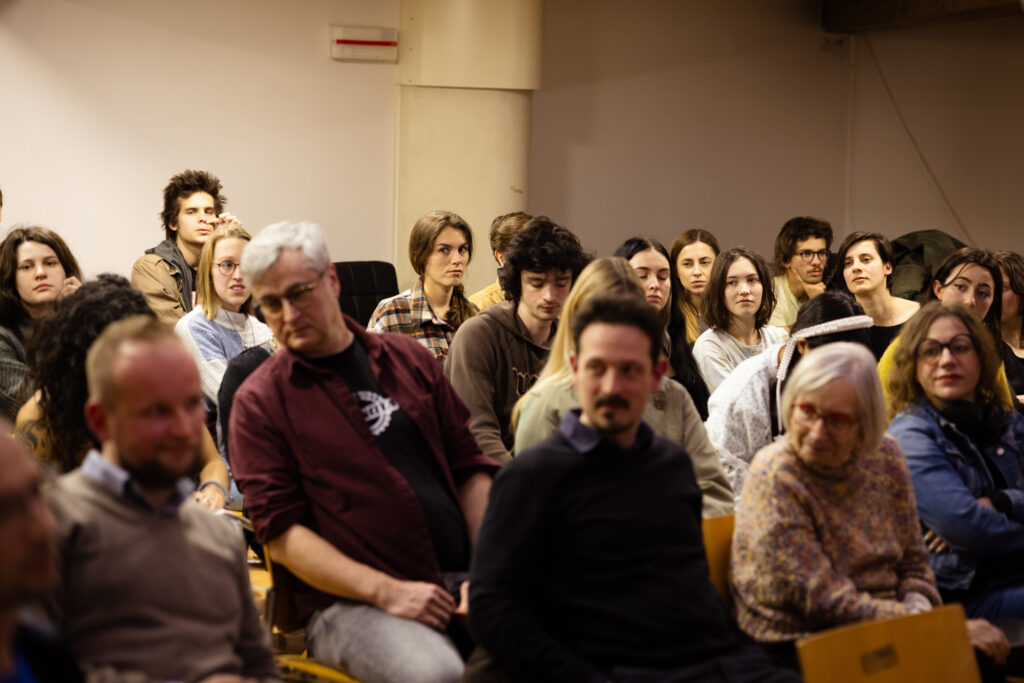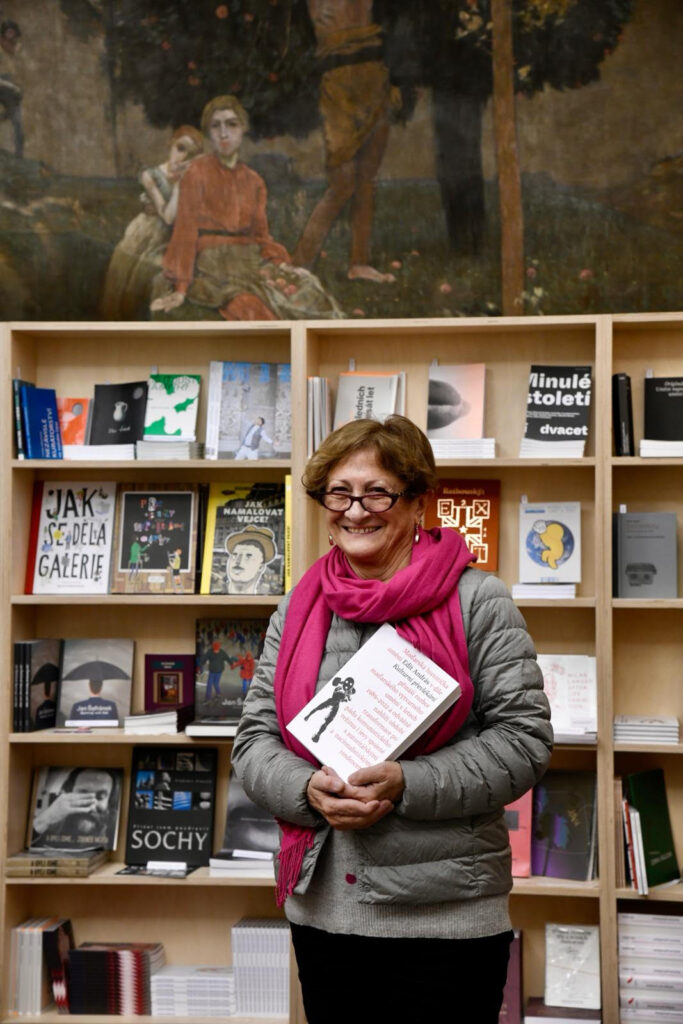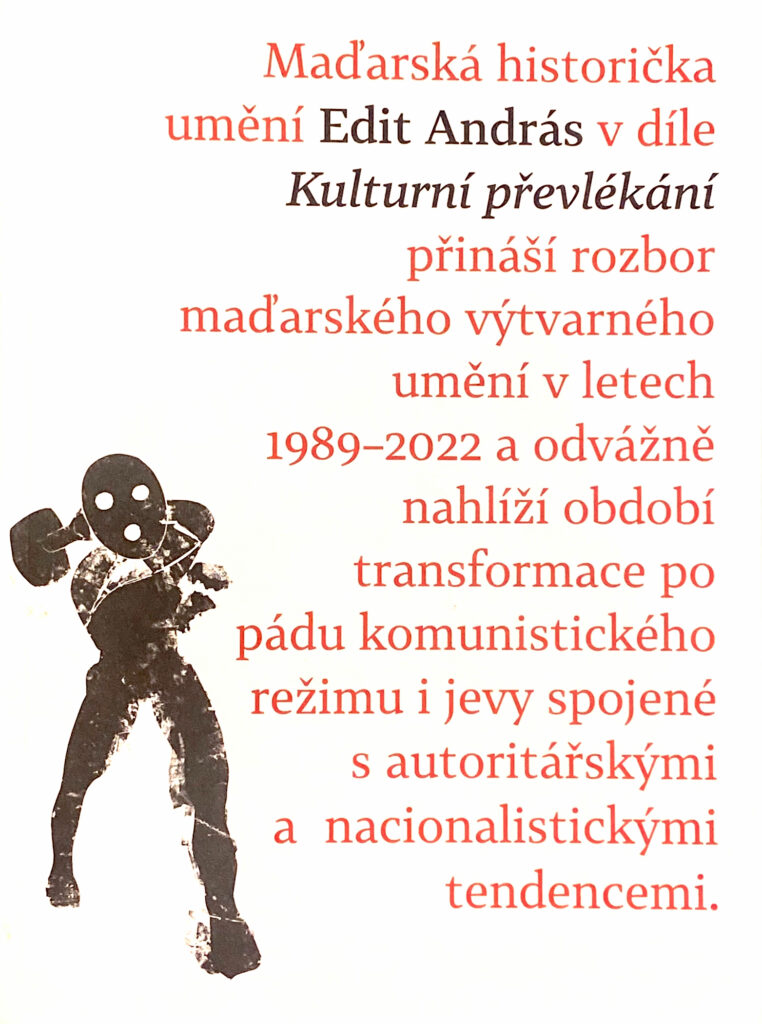
[Cultural Crossdressing: Art on the Ruins of Socialism and on the Pinnacles of Nationalism] Kulturní převlékání. Umění na troskách socialismu a na vrcholcích nacionalismu, Galerie moderního umění v Hradci Králové, 2024 [in Czech]
SUMMARY
This book, titled Kulturni prevlékáni. Umèni na troskách socialismu a na vrcholcich nacionalismu (Cultural Crossdressing. Art on the Ruins of Socialism and on the Pinnacles of Nationalism), is a Czech translation of selected parts from two related books by Hungarian art historian and theorist Edit András. The first of the two, Kulturális átöltözés. Múvészet a szocializmus romjain (Cultural Crossdressing.Art on the Ruins of Socialism, 2009), looked at the Hungarian art scene, artistic trends, and artists during the transformation era (1989–2010). Selected parts of this book form our new publication’s first section, titled “I. Art on the Ruins of Socialism” (I. Umèni na troskách socialismu). The second book, Határsértő képzelet. Kortárs művészet és kritikai elmélet Európa keleti felén (Imaginary Transgression. Contemporary Art and Critical Theory in Eastern Europe, 2023) – sections of which make up the second part of our publication, “II. Art on the Pinnacles of Nationalism” (I. Umèni na vrcholcich nacionalismu) – explored the period after 2010 and built on the ideas developed in the first book, which chronologically ended at the time of rising nationalist tendencies in Hungary…
The publisher of this Czech translation, the Gallery of Modern Art in Hradec Králové, has chosen to include in its edition mainly those passages that describe the Hungarian art scene and the works being made by Hungarian artists. Nevertheless, great care was put into the selection of these passages, which author Edit András made with a view to providing at least a partial theoretical framework, necessitated among other things by the fact that her approach to thinking and writing about Hungarian (but not just Hungarian) culture and art is founded on critical theories for writing on contemporary art. Her intention was not to present a comprehensive overview of art, but instead to focus on those areas that she considered crucial, valid, and relevant from a present-day perspective. In her analysis and study of art, she uses the methods of critical art history writing.
The first part of our book, “I. Art on the Ruins of Socialism”, looks at the Hungarian art scene in the 20 years after the fall of state socialism. Its central theme is the transformation of art-making practices, theory, and artistic positions. The artists mentioned in the text actively contributed to the production of new knowledge and new concepts, explored the events and processes that were a part of these changes, enabled the free flow of previously repressed emotions, and in some cases revealed hidden contradictions.
In the introduction to this section, the chapter titled “I.1. A Painful Farewell to Modernism” (I. Bolestné louceni s modernismem), András presents the argument (proffered in various permutations since the 1990s) that the specific character of “unofficial” art in the Eastern Bloc rested in its combination of conceptualism and modernism. Within the local context, conceptualism was not a deconstruction of modernism (as was the case in the West in the late 1960s and early 1970s during the dematerialization and subsequent deconstruction of identities or power relations) – it was a further iteration thereof. In eastern Europe, the deconstruction of modernism would have to wait until post-conceptualism, which András associates with the post-1990 generation. After 1989, Hungary’s once progressive neo-avant-garde found itself in a position of power, from which it quickly came into conflict with the newly emerging generation of artists. As András shows, this was more than an intergenerational conflict – it was also a conflict between discourses, and also genders, since the new generation included a significantly larger number of women than those that preceded it.
In the chapter “I.2. The Landscape after (a Never Fought) Battle” (I.2. Krajina po [nikdy nesvedené] bitve), András presents the work of Emese Benczúr as an example of post-conceptual practice. In her view, Benczúr’s art is an ideal representation of how such practice differs from earlier practice: it is material (András writes of “materialized conceptual practice”) and also unmistakably affective and personal; it explores personal identity and contains clear elements of institutional critique, specifically a critique of the patriarchal order prevailing in the art world. Another example of post-conceptualism possessing aspects of institutional critique is the work of the artistic duo known as Kis Varsó (Little Warsaw).
András subsequently calls attention to the subject of collective memory and the trauma of the socialist past. She opens this section by recalling the Albanian-born Anri Sala’s iconic work titled Intervista (1998). Via the example of Kis Varsó’s piece for Amsterdam’s Stedelijk Museum in 2004 and Andreas Fogarasi’s work for the national pavilion at the 2007 Venice Biennale, András demonstrates the taboo nature of the socialist past and the concomitant inability of Hungarian art critics, even in the first decade of the new millennium, to appreciate artistic practice that attempted to work with this subject.
In the next chapter, “I.3. Clearing the Debris” (1.3. Odklizeni trosek), we encounter the figure of the “vacuum” a temporary freeing-up of space that a considerable number of women artists managed to infiltrate in the first half of the 1990s. In this con-text, András recalls the series of exhibitions called Water Ordeal (Vízpróba). After a brief theoretical excursus summarizing the reflection of physicality in contemporary visual studies and art history, she presents various trends and approaches offering an overview of the artistic practice of roughly a dozen women artists: Mária Berhidi and Marianne Csáky, whose work from the late 19705 to the 1990s possesses remarkable echoes of surrealist visuality; Ilona Németh and Luca Gőbölyös, who engaged in a critique of social expectations of women; and Krista Nagy, and Rita Varga, in whose creations András sees elements of the abject, the grotesque, and, in extreme cases, representations of death. This part dedicated almost exclusively to women artists is complemented by a look at male artists Tibor Gyenis and Imre Gábor. Thus concludes the first section of our book.
The book’s second section, “II. Art on the Pinnacles of Nationalism”, looks at phenomena from the period between 2010 and today, with a particular focus on authoritarian and nationalist tendencies. Given the robust nature of this phenomenon, in this section András takes a closer look at works that interpret, subvert, and resist these changes. She pays special attention to socially engaged, socially sensitive, and critical works.
The section thus opens with a passage that recalls the sections in the first part of her older book focused on the subjects of trauma, memory, and amnesia. In the chapter titled “II.1. A Changing of the Guard in Culture” (I.1. Stridáni strázi v kulture), András recapitulates the changes that have transformed the Hungarian artistic landscape over the past 13 years. She here works with the term “cultural epoch,” taken from a speech given by Viktor Orbán at a summer university in the Transylvanian town of Tusnádfürdő in 2018, following Fidesz’s third electoral victory. Among other things, she lists the most important changes that accompanied the construction of this cultural epoch in the field of so-called fine art, such as the annexation of the Hungarian National Gallery by the Museum of Fine Arts (2011), the transformation of the Hungarian Art Academy (MMA) into a public institution through which funding continues to flow into the field of conservative and national fine art (2011), the removal of Barnabás Bencsik from his position as director of Budapest’s Ludwig Museum (2013), the transfer of the Műcsarnok exhibition hall under the purview of the MMA (2013), and limits placed on professional organizations involvement in the decision-making process concerning the disbursement of subsidies
(2015). The chapter concludes with a look back at two recent examples of politically engaged art in the public space: Dávid Adamkó’s “video demonstration” Willfulness (Önkény) and Zsuzsanna Szegedi-Varga’s projection I Want a Prime Minister (Miniszterelnököt akarok), which works with motifs from Zoe Leonard’s 1992 poem “I want a president”.
The next chapter, “II.2. Specters of History” (II.2. Strasidla dejin), is a loose continuation of a subject already found in the author’s older book – in particular in the sub-section “The National Mythology Built on Defeat’ (Národni vedomí porazeného), in which András focuses on the national tragedies and traumas that have shaped Hungarian national identity. As a fundamental trauma, she mentions the Treaty of Trianon (1920), the signing of which caused Hungary to lose significant territories that had been a part of Hungary before the First World War, and which overnight made a large number of ethnic Hungarians residents of other countries. Using the works of Szabolcs KissPál and Mária Chilf, both of whom come from Transylvania (one of the regions that Hungary lost because of Trianon), András shows how art can critique the neo-colonial narratives associated with the invocation of the Trianon trauma.
András presents Martin Piacek’s long-term project Embarrassing Moments in Slovak History (Najväcsie trapasy slovenskej histórie) as a (self-)ironic counterpoint to the narrative construction of national identity around a shared trauma. Like Ilona Németh or also András Cséfalvay, Piacek is an artist who moves between Slovak and Hungarian cultural circles.
In “II.3. Imagined Communities, Private Imaginations” (I.3. Ima-ginárni spolecenstvi, soukromé predstavy), András engages in a comprehensive reflection on the traveling exhibition A Private Nationalism (Privát nacionalizmus), among them its first iteration presented in 2014 at the Kunsthalle in Kosice. In this chapter the author presents a distinctive “topography” of art that offers a meditation on and critique of nationalism. A rapid succession of shorter sections titled simply “Homo Nationalicus” and “National Symbols” (Národni symboly) delineates nationalism’s imagined territory through its attributes and manifestations. Within this context, the author mentions the work of artists such as Imre Gábor, Dalibor Baca, Ádám Albert, Jaro Varga, Société Réaliste, and Rudolf Pacsika, among others.
In the final parts of the book’s second section, specifically in the chapter “On This or on That Side of the Border” (Pred hranici, za hranicí), András looks at the extended presentation of Private Nationalism in Vienna. Titled Universal Hospitality (2016), the exhibition took place just as the “refugee crisis” was reaching its peak and the Hungarian government’s actions against migrants and its construction of a fence on the border with Serbia revived the narrative of Hungary as the guardian of European (i.e., Christian) cultural identity.
In the sub-section, “Foreign Lands of the Mind” (Mentálni zahra-nici), András looks at policies aimed at excluding marginalized bodies from the majority “body” of the imaginary national commu-nity. She presents art that explores Romany culture and history and the presence of the Romany minority in Central and Eastern Europe. Here, works by Romany artists Omara and also socially sensitive artists such as Rita Varga and Csaba Nemes are discussed alongside works by the Russian-born former member of the Chto delat? artists’ collective Natalia Pershina-Yakimanskaya (a.k.a. Gluklya) and the Slovak artist Boris Ondreicka. At the opening of the book’s final chapter, “Imagination without Borders”, András observes: “The nation as an overarching structural unit and nationalism as an ideology providing a framework and narrative are so deeply rooted that even alternatives to them cannot completely shake them.” This section, which concludes the publication’s second part, “Art on the Pinnacles of Nationalism,” brings us up to the present day with a look at exhibition projects after 2020, including Dominika Trapp’s exhibition at Budapest’s Galerie Trafó. Trapp is a member of the Hungarofuturist circle, which emerged onto the scene with a manifesto published in 2017.
Among other things, this Czech edition offers an analysis of Hungarian art made from 1989 until the present day, but above all it is a bold look back at the last 30 years of transformation in the central European region. The author focuses on the cultural transformation and paradigm shift that have occurred since 1989, when theory and art criticism began to change their established positions just as the social status of art and its ways of adapting to the new situation were changing as well. She also takes a candid look at phenomena after 2010 that are associated with authoritarian and nationalist tendencies in Hungary. Naturally, these changes also affect the manner in which art is received.
(Written by Jan Zálešák, translation: Stephan von Pohl)
